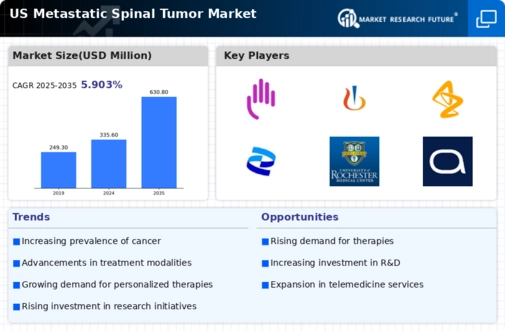The US Metastatic Spinal Tumor Market has witnessed significant advancements over the years, primarily driven by a surge in research and development efforts aimed at improving therapies and patient outcomes. Competitive insights into this market reveal a landscape characterized by innovation, consolidation, and a focus on precision medicine.
Manufacturers are strategically investing in novel treatment modalities, including targeted therapies and immunotherapies, with the intention of effectively addressing the complex nature of metastatic spinal tumors. Ongoing clinical studies and collaborations among industry players and academic institutions are shaping the future of therapeutic options available in the market.
Understanding the competitive dynamics of this sector involves not only reviewing the product portfolios of leading companies but also assessing their strategic positioning and market penetration.
Merck and Co has established a strong presence in the US Metastatic Spinal Tumor Market, focusing on developing innovative treatments that leverage advanced research methodologies. The company's strengths lie in its diverse portfolio of oncology products, which are aligned with cutting-edge therapeutic innovations addressing unmet medical needs.
Merck's commitment to research and development, coupled with its robust distribution network, enables the company to deliver highly effective medications to healthcare providers and patients alike. Its established relationships with oncologists and comprehensive clinical support services further bolster its position in the market, allowing for timely and effective treatment solutions tailored to individual patient needs.
Additionally, Merck's ongoing collaborations and partnerships reinforce its competitive edge, enabling access to a wider range of therapeutic advancements and increasing its market share.
Bristol Myers Squibb is another key player in the US Metastatic Spinal Tumor Market, renowned for its focus on developing life-saving treatments for cancer patients. The company is known for its key oncology products, which have shown promising results in targeting specific cancer pathways.
Bristol Myers Squibb's strengths lie in its extensive research capabilities, which have been enhanced through strategic mergers and acquisitions aimed at broadening its therapeutic portfolio. This strategic consolidation has not only expanded the company’s capabilities but also reinforced its market presence.
The firm continuously invests in clinical trials, exploring novel combinations and treatment regimens that improve patient outcomes. Additionally, Bristol Myers Squibb's strong relationships with healthcare practitioners and its commitment to patient advocacy further enhance its competitive position, making it a formidable entity in the US Metastatic Spinal Tumor Market by continually pushing the boundaries of cancer care.











